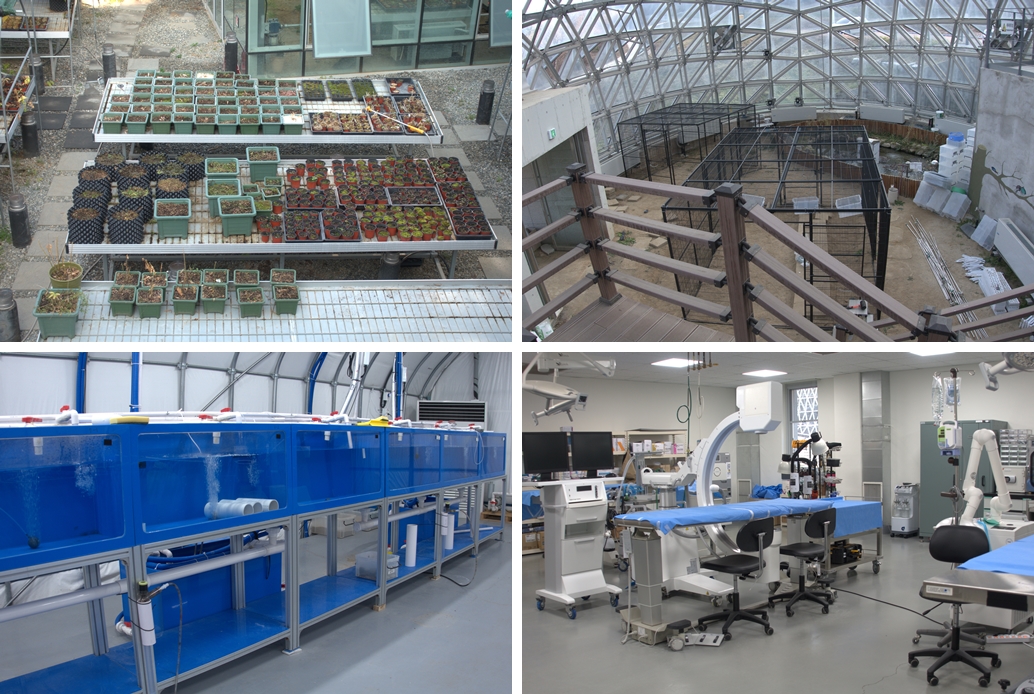Information Center
- Main page
- Information Center
- Government News
Government News
- Source
- korea.net
- Date
- 2024.12.26

The Research Center for Endangered Species was opened in October 2018 by the Ministry of Environment in Yeongyang-gun County, Gyeongsangbuk-do Province. (National Institute of Ecology)
By Gil Kyuyoung
Twenty years ago, the Asiatic black bear was released back into the wild.
In 2004, the Ministry of Environment and Korea National Park Service adopted six such bears from Primorsky Krai in Russian Far East and released them into the wild to restore them in Korea. Today, about 80 such furry creates live around Jirisan Mountain in Gyeongsangnam-do Province.
The bears disappeared from the country due to poaching and destruction of their habitats, but they live again in the forests of Jirisan. The project for their recovery is considered a benchmark for restoring an endangered species in country, proving that humans and nature can coexist harmoniously.
In October 2018, the ministry opened the Research Center for Endangered Species (RCES) in Yeongyang-gun County, Gyeongsangbuk-do Province, to expand projects to restore species under threat of extinction. Covering 2.25 million square m, or about the size of 254 soccer fields, the complex has state-of-the-art facilities including research buildings, indoor and outdoor breeding grounds, fields for releasing species back into the wild, greenhouses and biospecimen banks.
"This is Korea's first facility to specialize in research on endangered species as well as a rare case worldwide," RCES Director Choi Seung-woon said, beaming with pride.

Clockwise from left is a greenhouse for plants, one for insects, veterinary clinic, and research wing for fish and invertebrates. (Gil Kyuyoung)
As of this year, the ministry has 282 designated endangered species. The RCES restores them through the stages of adoption of the original species, restoration and breeding, and post-monitoring. Researchers from all over the nation visit to secure original species.
RCES staff is said to do everything for their mission, from climbing cliffs on an island to going underwater. Once they secure an original species, they begin by breeding it through development of technologies for restoration and proliferation by repeatedly studying conditions that preserve the species longer and stimulate reproduction.
In 2019, the RCES restored four species -- the Saunders's gull, otter, Seoul pond frog and spotted lady's slipper -- and has since released 17 endangered species back to the wild.
Among these, the leading success case was the dung beetle, which rolls feces into balls and buries them in the ground, raising the fertility of soil and cleaning the ecosystem. This earned the insect the moniker "nature cleaner."
The once-numerous dung beetles all but disappeared from the domestic ecosystem from the 1970s due to higher use of insecticide and agricultural pesticide. In 2017, the ministry even issued a public bid to purchase 50 dung beetles for KRW 50 million but none were found nationwide.

The Research Center for Endangered Species in September 2023 holds an event to release 200 dung beetles at Sinduri Coastal Sand Dune in Taean-gun County, Chungcheongnam-do Province.
In the end, the RCES purchased hundreds of dung beetles from Mongolia and released 200 of them at Sinduri Coastal Sand Dune in Taean-gun County, Chungcheongnam-do Province. Today, about 400 of the bugs live at the center, which receives retired horses from the Korea Racing Authority to secure the feces necessary to rear the beetles.
Choi said, "Dung beetles can easily die if they consume dung containing agricultural pesticide or antibiotics, so the center rears horses to provide adequate food."
Another RCES success story is the black-faced spoonbill, an endangered species in Northeast Asia. About 90% of such birds worldwide breed in Korea but their number is falling every year due to marine pollution destroying their habitats.
To resolve this problem, the RCES seeks to improve the bird's habitat and protection. It built fences at Namdong Reservoir, the spoonbill's main breeding area, to prevent entry by raccoons, the main predators of the birds, and installed an artificial rock in the group breeding colony of Gaksiam Rock on Ganghwa-do Island off the coast of Incheon.
The goal is to raise the spoonbill population to 5,000 by 2027.

Korea is the breeding ground of around 90% of the world's black-faced spoonbills, an endangered species in Northeast Asia. (National Institute of Ecology)
The RCES also seeks to raise awareness of biodiversity preservation. The "Black-faced Spoonbill Preservation" run by the fishing village in Incheon's Ganghwa-gun County is a leading example of capacity-building education and cooperation for fishermen. This is because the fishermen share information on the number and habitats of spoonbills to help the bird's restoration.
In September, the fishermen also visited excellent venues for coexistence with endangered species at Suncheon Hooded Crane Center in Suncheon, Jeollanam-do Province; Yesan Stork Park in Yesan-gun County, Chungcheongnam-do Province; and DMZ Peace Town for Migratory Birds in Cheorwon-gun County, Gangwon-do Province. These sites are considered exemplars of coexistence with endangered species.
Yang Min-seung, an associate researcher on the RCES bird team, said, "Until last year, many fishermen opposed spoonbill restoration but they now lead the way to inform us about the bird's status."
Last month, the National Institute of Ecology opened a restoration training center to raise public awareness of wildlife and develop human resources for species recovery.
"We cannot prevent the number of endangered species from rising if their habitats are destroyed due to industrialization and reckless development," Choi said. "Our ultimate goal is to promote awareness of the importance of biodiversity and preserve its value."
"We will not stop our research until we shut down the research center because all endangered species are no longer in danger."
gilkyuyoung@korea.kr